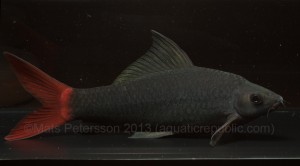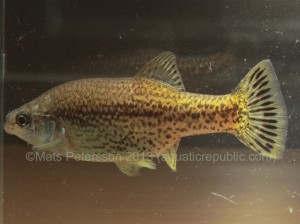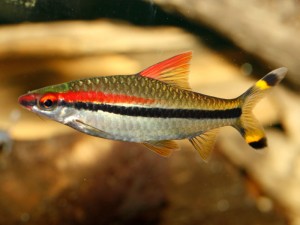Following on from our article Wild Caught or Captive Bred?, this article aims to help a potential purchaser choose their species in a sustainable way by explaining how to check the IUCN Red List status of aquarium fish. Unfortunately it’s not possible to give any 100% guarantees as there are too many variables to consider, however, we hope this article will give you some ideas about how to find information and what to look for when deciding on your purchase.
The Wild Caught or Captive Bred article explains how fish are either bred in captivity or taken from the wild. Which is ‘best’ depends very much on the species in question, and the methods of producing that species for the aquatics trade. It also depends on the personal ‘stance’ of the purchaser as we each have different opinions on things and these opinions are usually influenced by a number of factors. It’s reasonable to say that, depending on various factors, the argument over whether to choose wild caught or captive bred fish can be made either way for a given situation and/or species.
However, there is one case where we think choosing captive bred sources is definitely the winner and that is when a species of fish is under threat; particularly if that situation is caused directly by over-fishing for the aquatics trade.
How do we know if the species is under threat?
One of the fundamental difficulties is knowing whether a fish is threatened or not. Fortunately, both for the potential purchaser and many endangered species throughout the plant and animal kingdom, there is help at hand in the shape of an organisation called International Union for Conservation of Nature (IUCN). This global organisation helps bring together various types of conservation organisations, both global and local, government and independent. At the time of writing, the IUCN has around 1200 different member organisations. The IUCN co-ordinates scientific research and various projects, as well as aiming to influence the powers that be to conserve natural resources and maintain stable and sustainable populations of wild animals in their natural habitats.
As part of the research side of the IUCN, they maintain a list of threatened species, known as the IUCN Red List, a project that started in 1963. This list indicates whether a species is threatened with extinction, or is already extinct, based upon available research and evidence. The categories of extinction threat are shown in the table below:
| Least concern | Not considered to be under threat of extinction |
| Near threatened | Likely to become endangered in the near future |
| Vulnerable | High risk of endangerment in the wild |
| Endangered | High risk of extinction in the wild |
| Critically endangered | Extremely high risk of extinction in the wild |
| Extinct in the wild | Only known in captivity or in regions outside its historic range |
| Extinct | No known individuals remaining |
There are also two forms of ‘status’ indicators which indicate that a species has not been sufficiently investigated:
| Data deficient | There is not enough data to determine if the species is under threat or not |
| Not evaluated | No research has been done on the species’ status |
When determining these status indicators, the researchers will look at the known numbers of animals, but also how far apart they live, how many are mature, their habitat, etc.
The IUCN Red List is the basis of an international agreement, termed the Convention on International Trade in Endangered Species of Wild Fauna and Flora (CITES). The countries that agree to CITES have, in simple terms, agreed to not trade in wild animals or plants that are endangered. The details are inevitably more complex and can be found in this wikipedia article, which goes into more depth on the subject, there is also a section dedicated to CITES further down this article (new as of November 2013).
By consulting the IUCN Red List, it can be determined if a species is threatened or not; buying wild caught fish that are known to be threatened would be an irresponsible act.
The reasons for a species being under threat can be many and varied. Some have been threatened by over-collection for the aquatics trade; some by industrial activity affecting their environment, including pollution; some by building projects destroying their habitats. Unfortunately it’s fair to say that human activity is responsible, in one way or another, for the majority of species that are threatened and in decline.
Even if the threat isn’t directly related to the aquatics trade, for example an industrial project destroying the habitat, it’s not unreasonable to say that the higher the number there are left in their natural environment the better the survival rate may be. This is of course taking a very ‘broad-brush’ approach; sometimes the prospects of survival are minimal and it would be easy to argue that the more that are collected for the aquatics hobby the better. However, nothing is ever so simple, and hiding the problem by removing some of those species affected does not make it go away. Simply removing a species from somewhere does not guarantee that it will survive for posterity. A few individuals scattered throughout hobbyists’ tanks rarely constitutes a viable and sustainable conservation programme.
Conversely, if hobbyists are looking for captive bred specimens of these threatened species it is likely to help create a ‘safe haven’ within the captive bred industry and help secure a future for them. Captive breeding programmes often need wild caught specimens in order for a successful programme to be established, but the numbers required for that are far fewer than if the entire trade was being supplied with wild caught specimens and nothing else. However, the captive bred trade will only breed those species that have a customer demand; market forces rather than conservation are generally the driving force within the trade. The ‘hobby’ is one thing, but trade is trade and if no one wants to buy your carefully reared species there is little business sense in continuing with them, endangered or not.
The moral and ethical arguments are incredibly complicated and will always be influenced by the beliefs and values of the individual. It’s a very interesting field of discussion and we hope that some of the points we’ve mentioned above will get our readers thinking about the bigger picture and make their choices based on a more considered perspective.
How to find out if a species is on the IUCN Red List?
The IUCN’s own page has a search function, where the user can enter the common or scientific name of the species, and it will display the status. On the websites aquaticrepublic.com and planetcatfish.com, the species entries have an IUCN Red List status field under ‘habitat information’ to indicate their IUCN Red List status. This is given for all species that are on the Red List (and that are in the respective site’s database). If there is no Red List status shown, it means the fish is not on the IUCN Red List.
Aquaticrepublic also has a search function on the home page (the page titled ‘The aquarium fish website’) where you can search by all sorts of things including Red List status, although you may have to register with the site to do so (but it’s well worth the few seconds it takes to do so). This search is intended to be used as a combination search e.g. “Species in Cyprinidae that are endangered” so bear this in mind when using it and try and narrow down your search query accordingly in order to get the best results from it. If you’re interested in a list of everything that’s endangered (and listed on aquaticrepublic) you can use this link, and can narrow down the search using the criteria listed at the top of the page. Most species listed on Wikipedia also have their IUCN Red List status provided alongside.
It should be noted that the IUCN Red List is not a complete list of every species of fish. The total list actually contains around 49,000 species, covering everything from insects to giant redwood trees. The known species of fish number around 30,000 alone, so there is clearly work to be done by the IUCN to investigate the rest of the world’s fish.
If the species you are looking for is listed as “Near Threatened” or worse and you wish to pursue its purchase, then you should ensure it is from a sustainable source, for example a captive breeding program of some sort, either in the country of origin, a local community of fishkeepers, or undertaken within the shop itself. It can sometimes be hard to determine if fish are from captive bred stock or sourced from the wild, however, responsible shops will know where their stock is from.
Online forums can also be a great source of information about breeding activities and the availability of certain species. There are dedicated, expert breeders throughout the world, many of whom operate on a small scale focussing on a few specialist species. These ‘home grown’ sources can often be a great means of acquiring something a little more unusual so check out our recommended forums, and the additional information section in our researching fishkeeping article.
IUCN Red List – some examples
There are some popular ornamental aquarium species which feature on the IUCN Red List for various reasons.
The red tailed black shark (Epalzeorhynchos bicolour) is a popular aquarium species but sadly this species is critically endangered, if not extinct, in the wild. The IUCN Red List entry for it states that “currently the major threat to the wild population is pollution from agricultural and domestic sources”. Fortunately for the red tailed black shark its striking colours make it a popular aquarium species so it is currently enjoying a degree of security as a captive farmed species.

A slightly less well known, but nonetheless relatively widely available species is the butterfly goodeid (Ameca splendens) which is classed as ‘extinct in the wild’ by the IUCN Red List (Red List entry), although some sources suspect there are still a very few wild populations left. This species is a livebearer which makes it relatively easy to breed in captivity. It’s attractive colouring and small size mean it’s quite a popular species which is fairly easy to accomodate.

A third example of a popular aquarium fish which features on the IUCN Red List is the red line torpedo barb (Puntius denisonii). The Red List entry for it cites habitat loss alongside exploitation for the ornamental fish trade as being some of the main causes for its decline. The spawning characteristics of the species also appears to contribute to its struggle to regenerate its populations. A fine example of the many and various factors that can all come together to place a species under threat.

As mentioned in our Captive Bred or Wild Caught article, sourcing fish from the wild which are not under threat is not generally a source of concern in terms of conservation, and there are some projects looking to help sustainable wild fisheries, such as the Project Piaba (who also have a new site currently under construction but worth keeping an eye on), but a check of the IUCN Red List as part of your fishkeeping research should be top of the agenda.
The IUCN Freshwater Fish Specialist Group – Home Aquarium Fish Sub-Group
The IUCN has a Freshwater Fish Specialist Group which was established in 2004 with the general aim of conserving the aquatic environment worldwide, maintaining fish biodiversity and ensuring sustainable fisheries in relation to people and water resource use. In October 2014 the IUCN FFSG launched a Home Aquarium Fish sub-group. The main goals of this group are:
- To identify, validate, and promote the conservation and wise management of wild populations of tropical fishes that are part of the home aquarium trade, as well as the ecosystems where they are found
- To support sustainable, socioeconomic, and environmental benefits for home aquarium fishing communities, especially living in regions of biological importance
- To develop and implement solutions that result in the most robust market for home aquarium fish that result in environmental protectionism, poverty alleviation, and climate stability.
Please see the HAFSG website for more information:
IUCN Freshwater Fish Specialist Group – Home Aquarium Fish Sub-Group
CITES
CITES stands for Convention on International Trade in Endangered Species of flora and fauna. CITES “is an international agreement between governments. Its aim is to ensure that international trade in specimens of wild animals and plants does not threaten their survival”.
CITES has recently published a searchable online database of all species listed under CITES. This is a useful tool for researching various species, although be aware that if the species is not listed under CITES a search will not return anything. You can filter by appendix I, II, or III, as well as by location. The advanced options allow you to tailor things a little more. You can also access a full species list.
Checklist of CITES species (searchable database)
CITES has also recently launched Species+ and says “Species+ is a new online resource providing comprehensive information on globally protected species. It includes all species covered by the Convention on International Trade in Endangered Species of Wild Fauna and Flora (CITES) and the Convention on the Conservation of Migratory Species of Wild Animals (CMS), as well as those included in the EU Wildlife Trade Regulations.”
It’s well worth spending some time reading around the CITES site as there is a wealth of information available.
Further information
IUCN Red List
IUCN Freshwater Biodiversity Unit
IUCN Marine Species
IUCN Freshwater Fish Specialist Group
IUCN Freshwater Fish Specialist Group – Home Aquarium Fish Sub-Group
CITES
arkive.org
Wild Caught or Captive Bred?
Author: Mats Petersson & Suzanne Constance
Photographs: courtesy of Mats Petersson at aquatic republic.com and from fishtanksandponds.co.uk under creative commons




